One box for all: Toll solutions of the future

Road toll has been around for a long time, going back to the Germanic tribes who charged travelers who wanted to cross over mountain passages. Over time, it has developed along with commercial and passenger road transportation into a complex system which covers not only roads, but also bridges, ferries and tunnels. DKV Mobility has been providing toll solutions for almost 90 years and has developed some of the most advanced toll payment devices currently on the market.
The main issue road transport companies are facing with toll is the complexity of systems used by each country. Not long-ago, truck windshields were full of toll units from each country the truck had to cross. A long collection of OBUs decorating the truck and complicating the truck driver’s life. However, this has started to change in the last decade thanks to the European Electronic Tolling Services – EETS which aims to harmonize as many systems as possible across Europe. Currently, the unique solution offered by DKV Mobility, called DKV BOX EUROPE, covers 13 toll systems across 11 countries. This complements the existing DKV Card payment option and route tickets solutions.
The DKV BOX EUROPE is a next generation easy to use device. It is plug and play so drivers don’t need to get the truck to the service for installing or moving it from one truck to another, it is easy to configure on the spot or remotely and allows communication of data for reporting and analysis in the online management platforms. All in one unit which DKV Mobility helped to develop.
Besides EETS, which is set to offer a homogenous regulatory standard, the technology will play a key role in the evolution of toll, and this is the highly debated 5G network. 5G has wide business applicability, and the toll segment will fully benefit from the reduced latency, increased bandwidth and the possibility to serve multiple applications. Thus, real-time communication will become even more reliable. Given the technology advance, according to market speculation it is possible that the on-board unit functions will be integrated in the telematic solutions, but this is just an idea for now yet to be tested. Moving further into the future, the toll systems could become a mechanism to reach different infrastructure goals linked also to passenger cars like collecting fuel taxes or reducing emissions.
Currently, there are still countries where different OBUs are needed. Having one box uniting all toll systems is still a vision of the future. But: there is a lot of movement. Like the whole industry, the toll segment is constantly developing and innovating. To make mobility more efficient and sustainable and to make the owners, the drivers and accountants happier.
